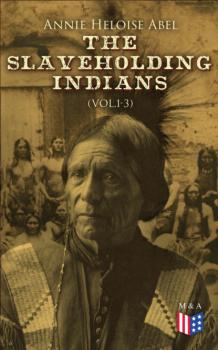ТОП просматриваемых книг сайта:















Annie Heloise Abel
Список книг автора Annie Heloise AbelАннотация
"The American Indian as Slaveholder and Seccessionist" by Annie Heloise Abel. Published by Good Press. Good Press publishes a wide range of titles that encompasses every genre. From well-known classics & literary fiction and non-fiction to forgotten−or yet undiscovered gems−of world literature, we issue the books that need to be read. Each Good Press edition has been meticulously edited and formatted to boost readability for all e-readers and devices. Our goal is to produce eBooks that are user-friendly and accessible to everyone in a high-quality digital format.
Аннотация
Holding humans in slavery was not a new concept to indigenous American peoples.In inter-Native American conflict tribes often kept prisoners-of-war, and these captives often replaced slain tribe-members. Africans were enslaved by Native Americans from the colonial period until the United States' Civil War. The interactions between Native American and Africans in the antebellum United States is complex. «The American Indian as Slaveholder and Secessionist» was among the first books which addressed this issue in a critical manner with a special emphasis on the relationship between the Indian nations and the Confederate States. Contents General Situation in the Indian Country, 1830-1860 Indian Territory in Its Relations With Texas and Arkansas The Confederacy in Negotiation With the Indian Tribes The Indian Nations in Alliance With the Confederacy
Аннотация
The American Indian in the Civil War is one of the first historical accounts dealing with the participations of Native American in the American Civil War. Native Americans took active participation in the conflict. 28,693 Native Americans served during the war, mostly in the Confederate military. They participated in battles such as Pea Ridge, Second Manassas, Antietam, Spotsylvania, Cold Harbor, and in Federal assaults on Petersburg. Contents The Battle of Pea Ridge, or Elkhorn and Its More Immediate Effects Lane's Brigade and the Inception of the Indian The Indian Refugees in Southern Kansas The Organization of the First Indian Expedition The March to Tahlequah and the Retrograde Movement of the «White Auxiliary» General Pike in Controversy With General Hindman Organization of the Arkansas and Red River Superintendency The Retirement of General Pike The Removal of the Refugees to the Sac and Fox Agency Negotiations With Union Indians Indian Territory in 1863, January to June Inclusive Indian Territory in 1863, July to December Inclusive Aspects, Chiefly Military, 1864-1865
Аннотация
The History of Slaveholding Indians is a three volume series dealing with the slaveholding Indians as secessionists, as participants in the Civil War, and as victims under reconstruction. The series deals with a phase of American Civil War history which has heretofore been almost entirely neglected or, where dealt with, either misunderstood or misinterpreted. Contents The American Indian as Slaveholder and Secessionist General Situation in the Indian Country, 1830-1860 Indian Territory in Its Relations With Texas and Arkansas The Confederacy in Negotiation With the Indian Tribes The Indian Nations in Alliance With the Confederacy The American Indian as Participant in the Civil War The Battle of Pea Ridge, or Elkhorn and Its More Immediate Effects Lane's Brigade and the Inception of the Indian The Indian Refugees in Southern Kansas The Organization of the First Indian Expedition The March to Tahlequah and the Retrograde Movement of the «White Auxiliary» General Pike in Controversy With General Hindman Organization of the Arkansas and Red River Superintendency The Retirement of General Pike The Removal of the Refugees to the Sac and Fox Agency Negotiations With Union Indians Indian Territory in 1863, January to June Inclusive Indian Territory in 1863, July to December Inclusive Aspects, Chiefly Military, 1864-1865 The American Indian Under Reconstruction Overtures of Peace and Reconciliation The Return of the Refugees Cattle-driving in the Indian Country The Muster Out of the Indian Home Guards The Surrender of the Secessionist Indians The Peace Council at Fort Smith, September, 1865 The Harlan Bill The Freedmen of Indian Territory The Earlier of the Reconstruction Treaties of 1866 Negotiations With the Cherokees
Аннотация
The History of American Indian in the Period of Reconstruction is a historical book which primarily deals with the establishment of a new relationship with the United States government and the great southern tribes. The book examines in great detail, the enormous price that the unfortunate Native Americans had to pay for having allowed themselves to become a secessionists and a soldiers. Overtures of Peace and Reconciliation The Return of the Refugees Cattle-driving in the Indian Country The Muster Out of the Indian Home Guards The Surrender of the Secessionist Indians The Peace Council at Fort Smith, September, 1865 The Harlan Bill The Freedmen of Indian Territory The Earlier of the Reconstruction Treaties of 1866 Negotiations With the Cherokees
Аннотация
The Slaveholding Indians is a three volume series dealing with the slaveholding Indians as secessionists, as participants in the Civil War, and as victims under reconstruction. The series deals with a phase of American Civil War history which has heretofore been almost entirely neglected or, where dealt with, either misunderstood or misinterpreted. Contents The American Indian as Slaveholder and Secessionist General Situation in the Indian Country, 1830-1860 Indian Territory in Its Relations With Texas and Arkansas The Confederacy in Negotiation With the Indian Tribes The Indian Nations in Alliance With the Confederacy The American Indian as Participant in the Civil War The Battle of Pea Ridge, or Elkhorn and Its More Immediate Effects Lane's Brigade and the Inception of the Indian The Indian Refugees in Southern Kansas The Organization of the First Indian Expedition The March to Tahlequah and the Retrograde Movement of the «White Auxiliary» General Pike in Controversy With General Hindman Organization of the Arkansas and Red River Superintendency The Retirement of General Pike The Removal of the Refugees to the Sac and Fox Agency Negotiations With Union Indians Indian Territory in 1863, January to June Inclusive Indian Territory in 1863, July to December Inclusive Aspects, Chiefly Military, 1864-1865 The American Indian Under Reconstruction Overtures of Peace and Reconciliation The Return of the Refugees Cattle-driving in the Indian Country The Muster Out of the Indian Home Guards The Surrender of the Secessionist Indians The Peace Council at Fort Smith, September, 1865 The Harlan Bill The Freedmen of Indian Territory The Earlier of the Reconstruction Treaties of 1866 Negotiations With the Cherokees
Аннотация
The American Indian as Participant in the Civil War is one of the first historical accounts dealing with the participations of Native American in the American Civil War. Native Americans took active participation in the conflict. 28,693 Native Americans served during the war, mostly in the Confederate military. They participated in battles such as Pea Ridge, Second Manassas, Antietam, Spotsylvania, Cold Harbor, and in Federal assaults on Petersburg. Contents The Battle of Pea Ridge, or Elkhorn and Its More Immediate Effects Lane's Brigade and the Inception of the Indian The Indian Refugees in Southern Kansas The Organization of the First Indian Expedition The March to Tahlequah and the Retrograde Movement of the «White Auxiliary» General Pike in Controversy With General Hindman Organization of the Arkansas and Red River Superintendency The Retirement of General Pike The Removal of the Refugees to the Sac and Fox Agency Negotiations With Union Indians Indian Territory in 1863, January to June Inclusive Indian Territory in 1863, July to December Inclusive Aspects, Chiefly Military, 1864-1865
Аннотация
Holding humans in slavery was not a new concept to indigenous American peoples.In inter-Native American conflict tribes often kept prisoners-of-war, and these captives often replaced slain tribe-members. Africans were enslaved by Native Americans from the colonial period until the United States' Civil War. The interactions between Native American and Africans in the antebellum United States is complex. «The American Indian as Slaveholder and Secessionist» was among the first books which addressed this issue in a critical manner with a special emphasis on the relationship between the Indian nations and the Confederate States. Contents General Situation in the Indian Country, 1830-1860 Indian Territory in Its Relations With Texas and Arkansas The Confederacy in Negotiation With the Indian Tribes The Indian Nations in Alliance With the Confederacy
Аннотация
The American Indian Under Reconstruction is a historical book which primarily deals with the establishment of a new relationship with the United States government and the great southern tribes. The book examines in great detail, the enormous price that the unfortunate Native Americans had to pay for having allowed themselves to become a secessionists and a soldiers. Overtures of Peace and Reconciliation The Return of the Refugees Cattle-driving in the Indian Country The Muster Out of the Indian Home Guards The Surrender of the Secessionist Indians The Peace Council at Fort Smith, September, 1865 The Harlan Bill The Freedmen of Indian Territory The Earlier of the Reconstruction Treaties of 1866 Negotiations With the Cherokees
Аннотация
"The American Indian as Participant in the Civil War" by Annie Heloise Abel. Published by Good Press. Good Press publishes a wide range of titles that encompasses every genre. From well-known classics & literary fiction and non-fiction to forgotten−or yet undiscovered gems−of world literature, we issue the books that need to be read. Each Good Press edition has been meticulously edited and formatted to boost readability for all e-readers and devices. Our goal is to produce eBooks that are user-friendly and accessible to everyone in a high-quality digital format.










